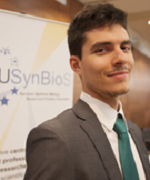Plant ProChip
Development of a microfluidic device for high-throughput analysis of genetic circuits in plant protoplasts.
This project aims to develop a high-throughput screen for the analysis of promoter sequences driving expression of a reporter gene in plant protoplasts. We envisage this device to be applicable to a range of plant species and cell types, and by coupling it to libraries of regulatory elements identified by DNase-Seq, it will rapidly increase the rate of identifying promoters for biotechnological applications.
The Idea
DNA regulatory elements are fundamental parts for genetic circuit design. The generation and characterization of promoter libraries can greatly facilitate fine tuning of gene expression within a circuit. We have used DNase-Seq (Meyer and Liu 2014) to identify candidate regulatory elements (>50,000) controlling cell-preferential gene expression within maize leaves (Burgess and Reyna-Llorens; unpublished data). Current validation techniques involve fusing sequences to a reporter and analysing expression in planta, which requires testing each element in an individual plant, either through transient biolistic transformation or the generation of stable transgenics (Brown et al. 2011). Applying these techniques to whole regulatory element libraries is not feasible at a laboratory scale.
This project aims to develop a high-throughput screen for the analysis of promoter sequences driving expression of a reporter gene in plant protoplasts. Protoplasts will be transformed by plasmid reporter constructs consisting of a regulatory region fused to a minimal promoter and a fluorescent protein. The expression level of fluorescent reporter within each protoplast will be questioned by laser in situ excitation in the sorting microfluidic device which will be also used to separate out individual protoplasts. Protoplasts will be sorted into two pools according to a user-specified threshold of fluorescence intensity (Abalde-Cela et al. 2015). In analysing a library of elements, this procedure will be performed iteratively at ever decreasing thresholds of fluorescence intensity to sort regulatory elements by their promoter activity. To determine which regulatory regions are present in each fraction, DNA will be extracted and sequenced using Illumina technology for each pool. We envisage this device to be applicable to a range of plant species and cell types, and by coupling it to libraries of regulatory elements identified by DNase-Seq, it will rapidly increase the rate of identifying promoters for biotechnological applications.
The Team
Dr. Steven Burgess,
Contract Research Staff, Department of Plant Sciences
Mr. Ivan Reyna-Llorens
Graduate Student, Department of Plant Sciences
Mr. Christian R. Boehm
PhD Candidate in Plant Synthetic Biology, Department of Plant Sciences
Dr. Sara Abalde-Cela
Postdoctoral Research Associate (PDRA) at Microdroplets Group, Department of Chemistry
Dr. Paul Bennett
Research Associate, Laboratory for Scientific Computing
Project Outputs
Project Report
Summary of the project's achievements and future plans
Project Proposal
Original proposal and application
Plant ProChip: Development of a microfluidic device for high-throughput analysis of genetic circuits in plant protoplasts.
Abstract
DNA regulatory elements are fundamental parts for genetic circuit design. The generation and characterization of promoter libraries can greatly facilitate fine tuning of gene expression within a circuit. Current validation techniques involve fusing sequences to a reporter and analysing expression in planta, which requires testing each element in an individual plant, either through transient biolistic transformation or the generation of stable transgenics (Brown et al. 2011). Applying these techniques to a considerable number of genetic circuits can be very laborious or not even feasible at a laboratory scale. The aim of this project was to use microfluidics to develop an inexpensive and high-throughput screening method for the analysis of genetic circuits in plant protoplasts.
Progress
- Generated a fluorescent reporter construct using Golden Gate Cloning.
- Fabricated a PDMS microfluidic device for encapsulation of plant protoplasts.
- Fabricated a PDMS microfluidic device for sorting of plant protoplasts.
- Established of a procedure for protoplast isolation from maize, arabidopsis and Nicotiana benthamiana.
- Established of a procedure for encapsulation of protoplasts.
- Established a procedure for PEG transformation of protoplasts followed by encapsulation.
- Established that protoplasts are stable in a microfluidic device.
- Established of a laser setup for analysis of fluorescence from plant protoplasts.
- Established a procedure for sorting protoplasts based on fluorescence intensity.
Outputs
- A blog which detailed project progress.
- Presentation at OpenPlant Forum, JIC, 2016
- Presentation at Cafe Synthetique, Cambridge, 2016
- Online protocols for protoplast isolation and encapsulation on protocols.io
Plans for follow up
- Develop an on-chip method of protoplast transformation to reduce DNA input requirements.
Write up and submission of methods article to an open access journal.








